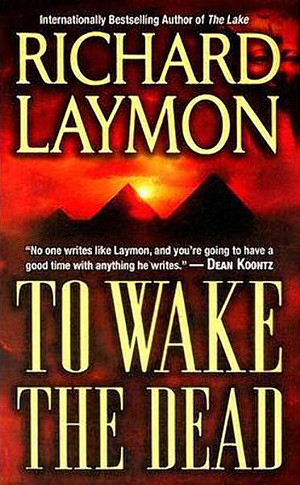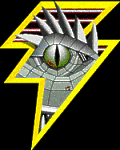 |
 |
Review by E.C.McMullen Jr. |
|

By Richard Laymon PB: 450 pages 47North: Reprint edition March 31, 2014 Language: English ISBN-10: 1477837132 ISBN-13: 978-1477837139 |
|||
Boy I tell ya! One minute yer robbing an estate to get some black market artifacts (or at least, they WILL be black market the minute they get into your hands!) and the next thing you know, someone is blowing yer damn face off with a shotgun!
And as if that wasn't bad enough, the person who owns them treasures soon gets eaten alive by one of the antiques!
Fine! I guess we just can't have nice things!
Richard Laymon's TO WAKE THE DEAD is typical Laymon, which means that it is pretty much like nothing you have ever read before. Unless, of course, you are a Laymon fan. But even if you are, you are going to get a big charge out of TO WAKE THE DEAD.
Forget the old Universal Pictures slow walkin' Mummies. Forget the latest Universal Pictures leap froggin' mummies played for laughs. Richard took the zombie approach with this Mummy tale and, as always, took it further.
TO WAKE THE DEAD revolves chiefly around two people, Susan Conners, assistant curator of the Charles Ward Museum (lots of Lovecraft references going on here), and Taggart "Tag" Parker, a Police Officer. After the death of the wealthy and rather quixotic collector, Robert Callahan, his main collection, a large cache of Egyptian artifacts, are willed to the museum. That includes, among other things, a sarcophogus and the mummy within.
The Mummy is Amara and she lives per a deal with one of the many forms of the debbil! As always when you sell your soul to the devil, what you ask for is not really what you wanted.
I can attest to that. This website isn't quite turning out the way I thought.
Amara lives only by night, sleeps by day, and her shrunken dried up body is nothing more than an empty vessel through which her damned spirit moves and is contained.
Amara is the Bram Stoker version of the Mummy, for anyone who ever read JEWEL OF THE SEVEN STARS. Bram's queen, "The Nameless One" (but her friends call her Tera) who insulted the Gods, for which the "Mummy" (from Boris Karloff to Arnold Vosloo) of the movies was resurrected, was far more wicked an item than her minor character priest, who was little more than a servant.
Richard Laymon brings the horror of mummies back to where Bram Stoker intended it to be, firmly with the women. In fact, this book dwells on women as both victims and objects of Horror. There is also the repugnant matter of Mabel, who not only has an overbearing crush on Taggart, but will stop at nothing to get Susan Conners out of the picture.
Simply put, Amara walks because she is after something and cannot rest until she gets it. She will kill anyone who gets in her way and her single minded determination makes a kind of sense for something that is a powerful shell inhabited by an equally powerful ghost.
Like all Laymon books there is plenty of sex and if this bothers you, you won't like this or any other Richard Laymon book. The screenwriting teacher, Robert McKee, says of Horror that the best way to break through the deepest part of a person's psyche is to present lots of sexual imagery (because that is the single thing that people are most psychologically uncomfortable with) and attack their Gods or their Mothers (because those two places are most people's last psychological and primal retreat). Richard Laymon does it all here with an unforgiving but realistic force.
Characters that you want to see die may live and characters that you want to live may die. In a Laymon book, there are no guarantees of life or happiness at all, not even among the heroes.
Laymon clearly defined those that were truly evil from those that did evil but could be redeemed. In TO WAKE THE DEAD, all those who do evil are united by a common theme, and that is that Evil is born in loss and the loneliness it brings.
There are missteps in this novel, most notably the subplot involving The Memoir's of Robert Callahan, which appear in the middle of the book. Though entertaining in itself - and for a Memoir intended to reveal the nature of Amara - it reads just as much as a voluptuary's feast of sexual shenanigans, as it does in revealing the nature of the mummy. It's meant to be the tool by which the protagonists can understand Amara, and so defeat her. Robert Callahan's adopted "son", Imad, is entrusted with seeing that the book is safely delivered to those who must defeat Amara, but in truth, the Memoir serves no purpose to the story or its conclusion at all.
Another subplot of the Beast House works much better and the overall effect of the book is fast and furious in typical Richard Laymon style. As a long time Laymon fan, I couldn't help but think that this was in many ways, a call back to Laymon's infamous THE CELLAR. I felt it had many of the same plot points and took their development and resolution in a whole new direction.
You do not need to read THE CELLAR to enjoy TO WAKE THE DEAD, but for those who are old fans of the master, he remains missed.
3 BookWyrms.



This review copyright 2003 E.C.McMullen Jr.
| CHANGE YOUR SHIRT | |
| FEO AMANTE'S HORROR THRILLER Created by: E.C.MULLEN JR. |
| COME FOLLOW ME @ Amazon |
| ECMJr |
| Feo Blog |
| IMDb |
| Stage32 |
| YouTube |
| Zazzle Shop |

